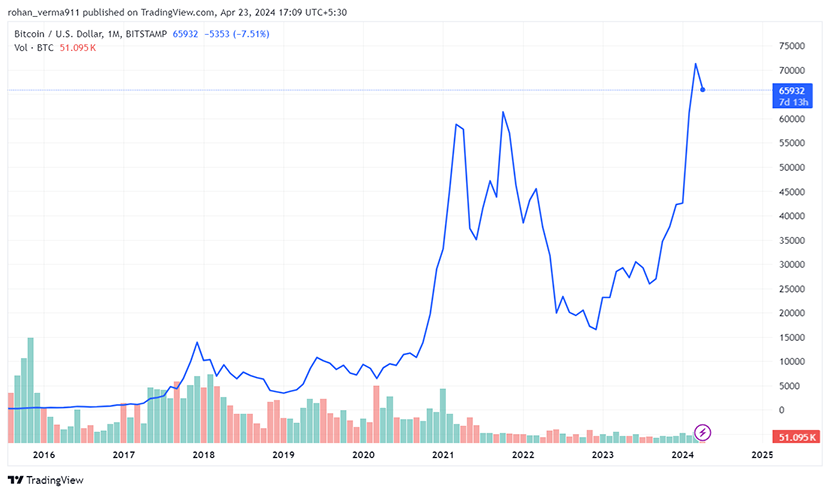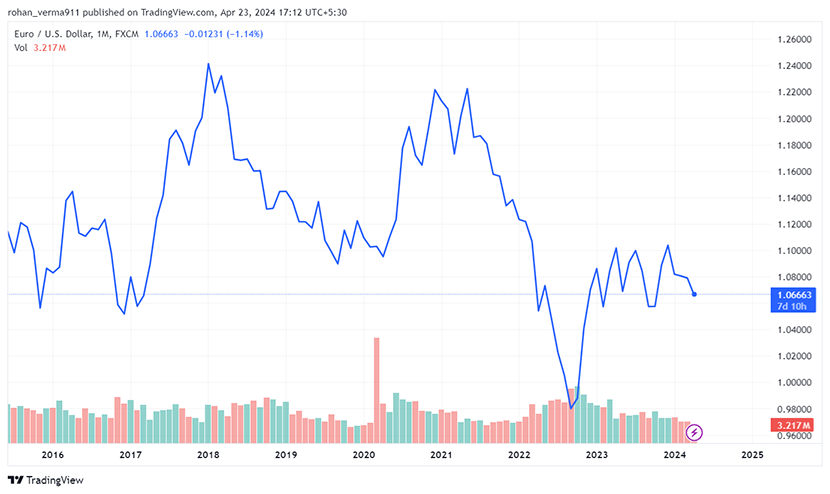Published on October 23, 2024 by Rohan Verma
In the realm of foreign exchange markets, the EUR/USD currency pair is a critical benchmark, reflecting the dynamics of two of the world’s largest economic zones. The performance of the EUR/USD in 2023 was characterised by significant volatility, attributed to global economic shifts and policy changes. However, Bitcoin (BTC), a newer entrant to financial markets, has shown resilience in the wake of increased volatility and regulatory constraints.
Historical performance and trends
Trading in the EUR/USD currency pair commenced in 1999, with the pair trading at around 1.1795; however, it has experienced substantial volatility since then. The most significant period in its history was the global financial crisis, when it rose sharply to an all-time high above 1.60 in 2008, with the USD plummeting against the EUR. The trajectory was eventually halted following the sharp decline in the subsequent years as the Eurozone grappled with its debt crisis. This presented an opportunity for the USD to regain its lost strength.
BTC's journey, from its inception in 2009 to 2023, has been a rollercoaster ride of volatility. In the diverse investment universe, BTC as an asset class has witnessed one of the most volatile histories. The cryptocurrency gained widespread attention due to its first price increase in October 2010, when the value of a single BTC zoomed past the long-standing price of less than USD0.10. A significant milestone in its history was in 2017, when its price soared to nearly USD20,000, only to crash in early 2018. BTC made headlines again in 2020 as its price rallied significantly, propelled by growing institutional interest and macroeconomic uncertainty. Despite this surge, its volatility in 2020 was notably lower on average than in previous years, indicating a degree of maturation in the market. BTC was trading at USD42,250 as of December 2023, marking a significant journey since its inception.
An unusual correlation
At face value, these two asset classes may appear to be uncorrelated, but a deeper analysis reveals a systemic relationship in the price movement of these two completely different asset classes. While many believe there is an inverse correlation between the USD and BTC, the perspective changes when you analyse the correlation between BTC prices and price changes in the EUR/USD pair.


There seems to have been negligible correlation between the two asset classes leading up to the pandemic; the EUR/USD pair witnessed a sharp increase while BTC was trading largely flat.
The first signs of positive correlation started to show during the pandemic as BTC jumped to an all-time high and the EUR/USD pair was on a strong uptrend.
The USD/EUR pair then recorded a low of USD0.90 as of 27 December 2023, corresponding with a steep decline in the BTC price.
The EUR/USD pair has steadied since the pandemic, with BTC following suit, as the chart above shows, although not indicating a very strong positive correlation.
Key takeaways:
BTC/USD and EUR/USD followed a trajectory that indicated a direct correlation between the two asset classes
BTC’s higher volatility explained the late bounce from the lows
A deeper analysis reveals that the movement in the EUR/USD pair may help gain an understanding for trading in BTC/USD
Are they correlated?
Factors supporting positive correlation:
Higher institutional and retail investor adoption rates have prompted BTC to closely follow the macroeconomic trends driving the EUR/USD pair
Both asset classes are seen as stores of value amid turbulent market conditions
Active managers and traders of alternative investments tend to invest in risker assets that are liquid in nature, with BTC and the EUR/USD pair being the most actively traded asset classes in the cryptocurrency and forex markets, respectively
Factors supporting negative correlation:
BTC has historically been negatively correlated with the dollar index (DXY); this index measures the greenback's exchange rate against major fiat currencies, including the EUR
In April 2023, the 90-day correlation coefficient between BTC and the DXY had slipped to a two-month low of -0.70, according to data from charting platform TradingView.
The correlation between cryptocurrencies and traditional asset classes has been uncharted territory until now, but researchers are looking to understand these alternative asset classes due to widespread institutional adoption. This has fuelled interest among both retail and institutional investors, revealing data that supports the hypothesis that the cryptocurrency is more correlated with classic financial markets than previously believed.
How Acuity Knowledge Partners can help
Portfolio monitoring by analysing existing exposure to alternative investment classes by providing ad hoc research and sector reports.
Regulatory framework analysis for BTC asset class along with in depth due diligence analysis for ICO’s for new companies.
Key trends and development analysis including M&A analysis for new blockchain startups, risk management reports, competitive intelligence and currency outlook reports.
Blockchain securitisation ad hoc support.
Sources:
EUR/USD and Bitcoin: an unusual correlation | Bitcoin Insider
EURUSD provides a way of understanding Bitcoin's market movements. (coinjournal.net)
What's your view?
About the Author
Rohan is aligned with Acuity’s Lending Services Division with over 13 years of experience in project execution and delivery of financial, valuation, credit risk analysis and strategy related projects for the Financial Institutions Group (FIG), Private Equity & Venture Capital, and Corporate clients. Rohan posesses an MBA with a specialization in Finance & Strategy along with the CMA and CFA designation.
He specializes in strategy development, deal structuring, financial analysis, DCF Valuation, trading comps, transaction comps, and financial modelling, and has in the past supported the deal structuring and corporate finance teams of various clients including the Big 4 firms. He has also proactively worked on various strategy and technology consulting assignments including a feasibility study. He currently supports one of the largest banks..Show More
Like the way we think?
Next time we post something new, we'll send it to your inbox









